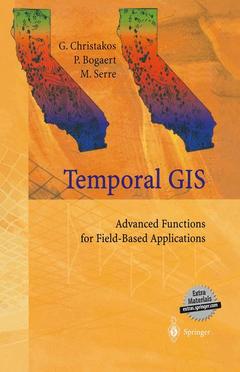Description
Temporal GIS, Softcover reprint of the original 1st ed. 2001
Advanced Functions for Field-Based Applications
Authors: Christakos George, Bogaert Patrick, Serre Marc
Language: English
Subjects for Temporal GIS:
Approximative price 158.24 €
In Print (Delivery period: 15 days).
Add to cart
Temporal GIS
Publication date: 10-2013
219 p. · 15.5x23.5 cm · Paperback
Publication date: 10-2013
219 p. · 15.5x23.5 cm · Paperback
Approximative price 158.24 €
Subject to availability at the publisher.
Add to cart
Temporal GIS, advanced functions for field-based applications(+CD-ROM)
Publication date: 01-2002
219 p. · 15.5x23.5 cm · Hardback
Publication date: 01-2002
219 p. · 15.5x23.5 cm · Hardback
Description
/li>Contents
/li>Comment
/li>
The book focuses on the development of advanced functions for field-based Temporal Geographical Information Systems (TGIS). These fields describe natural, epidemiological, economic, and social phenomena distributed across space and time. The book is organized around 4 main themes: concepts, mathematical tools, computer programs, and applications.
The reader is also familiarized with the TGIS toolbox of advanced functions and the associated library of comprehensive computer programs, BMElib.
The reader is also familiarized with the TGIS toolbox of advanced functions and the associated library of comprehensive computer programs, BMElib.
1 A BME View to the New Realities of TGIS.- 1.1 Introducing a Temporal Geographical Information System (TGIS).- 1.1.1 Purposefulness, Content, and Context.- 1.1.2 Synthesis, Organization, and Visualization.- 1.1.3 Action-Oriented.- 1.2 Field-Based TGIS.- 1.3 TGIS Functions.- 1.4 Novel Contribution to TGIS.- 1.4.1 BME-Based Advanced Functions.- 1.4.2 Stochastic Modelling.- 1.4.3 BMEIib Software.- 1.4.4 Epistemic Viewpoint.- 1.4.5 Scientific Hypothesis Testing and Explanation.- 1.4.6 Revisionistic Paradigm.- 1.5 Concluding Remarks.- 2 Spatiotemporal Modelling.- 2.1 Spatiotemporal Continuum.- 2.2 The Random Field Model.- 2.3 The Role of Metaphors in TGIS.- 2.4 The Importance of Physical Geometry.- 2.5 Synopsis.- 3 Knowledge Bases Integration.- 3.1 Integrating Knowledge Bases (KB) into TGIS.- 3.2 General KB and the Associated Physical Constraints.- 3.2.1 Space/Time Correlation Functions Between Two or More Points (Multiple-Point Statistics).- 3.2.2 Physical Models.- 3.3 Specificatory KB.- 3.3.1 Hard and Soft Data.- 3.3.2 The Effect of Soft Data on The Calculation of the Space/Time Correlation Functions.- 3.4 Accommodating Knowledge Needs.- 3.4.1 Knowledge Classification.- 3.4.2 Model Building and Reality Check.- 4 Spatiotemporal Mapping.- 4.1 A Formulation of the Spatiotemporal Mapping Problem.- 4.2 Formal BME Analysis and Mapping.- 4.2.1 The Basic BME Procedure.- 4.2.2 The Advantage of Composite Space/Time Mapping.- 4.2.3 Continuous-Valued Map Reconstruction.- 4.2.4 Modifications of the BME Procedure.- 4.2.5 Spatiotemporal Filtering.- 4.2.6 Spatiotemporal Mapping and Change-of-Scale Procedures.- 4.3 Other Mapping Techniques.- 4.3.1 Wiener-Kolmogorov Stochastic Interpolation.- 4.3.2 Geostatistical Kriging.- 4.3.3 Kalman-Bucy Filtering.- 4.3.4 Some Comparisons.- 4.4 Concluding Remarks.- 5 Interpretive BME.- 5.1 Interpretive Issues.- 5.2 An Epistemic Analysis of the BME Approach.- 5.3 Non-Bayesian Conditionalization.- 5.3.1 Material Biconditionalization.- 5.3.2 Material Conditionalization.- 5.4 By Way of a Summary.- 6 The BME Toolbox In Action.- 6.1 The Fundamental KB Operators.- 6.2 Step-by-Step BME.- 6.2.1 The Formal Representation.- 6.2.2 The Diagrammatic Representation.- 6.3 Analytic and Synthetic Case-Studies.- 6.3.1 Some Commonly Encountered Situations.- 6.3.2 Spatiotemporal Filtering.- 6.3.3 Exogenous Information.- 6.3.4 Physical Laws.- 6.3.5 Using Soft Data to Improve TGIS Mapping.- 6.3.6 Non-Bayesian Analysis.- 6.4 Quantifying the Mapping Efficiency of Soft Data.- 6.5 Numerical Investigations of Popular Techniques.- 6.5.1 The Use and Misuse of Soft Data by Statistical Regression-Based Techniques.- 6.5.2 The Inadequacy of Indicator Kriging.- 6.6 Merging Maps with BME.- 6.7 Synopsis.- 7 The BME Computer Library.- 7.1 Computational BME Analysis and the BMEIib.- 7.2 Getting Started.- 7.2.1 Notational Convenience.- 7.2.2 Getting Started with MatLab.- 7.2.3 Getting Started with BMEIib.- 7.3 The iolib Directory.- 7.3.1 The readGeoEAS.m and writeGeoEAS.m Functions.- 7.3.2 The readProba.m and writeProba.m Functions.- 7.3.3 The readBMEproba.m and writeBMEproba.m Functions.- 7.4 The graphlib Directory.- 7.4.1 The scatterplot.m function.- 7.4.2 The colorplot.m function.- 7.4.3 The marketplot.m function.- 7.4.4 The valplot.m function.- 7.4.5 A tutorial Use of the graphlib Directory.- 7.5 The modelslib Directory.- 7.5.1 The *C.m and *V.m Functions.- 7.5.2 The modelplot.m Function.- 7.5.3 A Tutorial Use of the modelslib Directory.- 7.6 The statlib Directory.- 7.6.1 The kerneldensity.m Function.- 7.6.2 The pdf2cdfm Function.- 7.6.3 The covario.m Function.- 7.6.4 The crosscovario.m Function.- 7.6.5 The crosscovarioST.m Function.- 7.6.6 A Tutorial Use of the statlib Directory.- 7.7 The bmeprobalib Directory.- 7.7.1 The proba*.m Function.- 7.7.2 The BMEprobaMoments.m Function.- 7.7.3 The BMEprobaMode.m Function.- 7.7.4 The BMEprobaPdfm Function.- 7.7.5 The BMEprobaCI.m Function.- 7.7.6 The BMEprobaTMode.m, BMEprobaTPdfm and BMEprobaTCI.m Functions.- 7.7.7 Working With Files.- 7.7.8 A Tutorial Use of the bmeprobalib Directory.- 7.8 The bmeintlib Directory.- 7.8.1 The BMEintervalMode.m Function.- 7.8.2 The BMEintervalPdf.m Function.- 7.8.3 The BMEintervalTMode.m Function.- 7.8.4 The BMEintervalTPdfm Function.- 7.8.5 A Tutorial Use of the bmeintlib Directory.- 7.9 The bmehrlib Directory.- 7.9.1 The kriging.m Function.- 7.9.2 The krigingfilter.m Function.- 7.9.3 A Tutorial Use of the bmehrlib Directory.- 7.10 Simulations.- 7.10.1 The simuchol.m Function.- 7.10.2 The simuseq.m Function.- 7.10.3 A Tutorial Use of the simulib Directory.- 7.11 The genlib Directory.- 7.11.1 The aniso2iso.m Function.- 7.11.2 The iso2aniso.m Function.- 7.11.3 The coord2dist.m Function.- 7.11.4 The coord2K.m Function.- 7.11.5 The kernelsmoothing.m Function.- 7.11.6 A Tutorial Use of the genlib Directory.- 7.12 The mvnlib Directory.- 7.12.1 The mvnlibcompile.m Function.- 7.12.2 Testing the mvnlib Directory.- 7.13 BMEIib Tutorials, Examples, and Tests.- 7.13.1 The tutorlib Directory.- 7.13.2 The exlib Directory.- 7.13.3 The testslib Directory.- 8 Scientific Hypothesis Testing, Explanation, and Decision Making.- 8.1 On Scientific Methodology.- 8.2 Hypothesis Testing.- 8.3 Scientific Explanation.- 8.4 Geographotemporal Decision Making.- 8.5 Prelude.- References.
Representation of powerful concepts and tools of modern geostatistics by one of the initiators
Step-by-step examples and applications
© 2024 LAVOISIER S.A.S.



